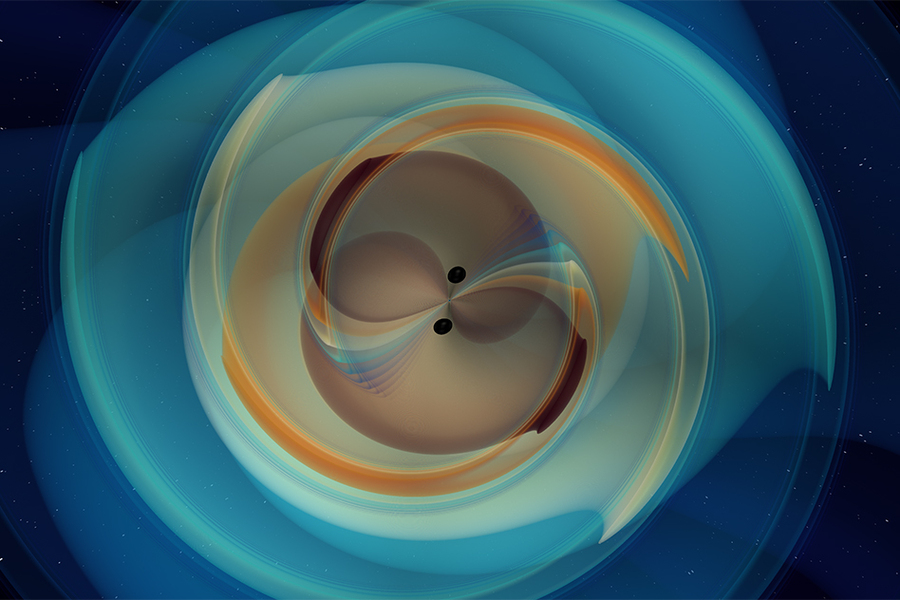Most Massive Gravitational-Wave Source Yet
Massachusetts Institute of Technology | California Institute of Technology |
Laser Interferometer Gravitational-Wave Observatory (LIGO) | 2020 Sep 02
A binary black hole merger likely produced gravitational waves equal to the energy of eight suns.
For all its vast emptiness, the universe is humming with activity in the form of gravitational waves. Produced by extreme astrophysical phenomena, these reverberations ripple forth and shake the fabric of space-time, like the clang of a cosmic bell.
- A still image from a numerical simulation of two black holes that inspiral and merge, emitting gravitational waves. The black holes have large and nearly equal masses, with one only 3% more massive than the other. The simulated gravitational wave signal is consistent with the GW190521 observation made by the LIGO and Virgo. (Credit: N. Fischer, H. Pfeiffer, A. Buonanno (AEI), SXS Collaboration)
Now researchers have detected a signal from what may be the most massive black hole merger yet observed in gravitational waves. The product of the merger is the first clear detection of an “intermediate-mass” black hole, with a mass between 100 and 1,000 times that of the Sun.
They detected the signal, which they have labeled GW190521, on May 21, 2019, with the National Science Foundation’s Laser Interferometer Gravitational-wave Observatory (LIGO), a pair of identical, 4-kilometer-long interferometers in the United States; and Virgo, a 3-kilometer-long detector in Italy.
The signal, resembling about four short wiggles, is extremely brief in duration, lasting less than one-tenth of a second. From what the researchers can tell, GW190521 was generated by a source that is roughly 5 gigaparsecs away, when the universe was about half its age, making it one of the most distant gravitational-wave sources detected so far.
As for what produced this signal, based on a powerful suite of state-of-the-art computational and modeling tools, scientists think that GW190521 was most likely generated by a binary black hole merger with unusual properties.
Almost every confirmed gravitational-wave signal to date has been from a binary merger, either between two black holes or two neutron stars. This newest merger appears to be the most massive yet, involving two inspiraling black holes with masses about 85 and 66 times the mass of the Sun.
The LIGO-Virgo team has also measured each black hole’s spin and discovered that as the black holes were circling ever closer together, they could have been spinning about their own axes, at angles that were out of alignment with the axis of their orbit. The black holes’ misaligned spins likely caused their orbits to wobble, or “precess,” as the two Goliaths spiraled toward each other.
The new signal likely represents the instant that the two black holes merged. The merger created an even more massive black hole, of about 142 solar masses, and released an enormous amount of energy, equivalent to around 8 solar masses, spread across the universe in the form of gravitational waves. ...
LIGO and Virgo Catch Their Biggest Fish So Far
Albert Einstein Institute | Max Planck Institute for Gravitational Physics | 2020 Sep 02
Virgo and LIGO Unveil New and Unexpected Black Hole Populations
Virgo Collaboration | 2020 Sep 02
New Populations of Black Holes Revealed by Gravitational Waves
National Center for Scientific Research, France (CNRS) | 2020 Sep 02
Scientists Detect First-of-Its-Kind Intermediate-Mass Black Hole
Northwestern University | 2020 Sep 02
Mammoth Collision of 'Impossible' Black Holes Detected for the First Time
Australian National University | 2020 Sep 02
A Heavyweight Merger
APS Physics Viewpoint | 2020 Sep 02
GW190521: A Binary Black Hole Merger with a Total Mass of 150 M⊙ ~ LIGO, Virgo, R. Abbott et al
- Physical Review Letters 125(10):1102 (02 Sep 2020) DOI: 10.1103/PhysRevLett.125.101102
- arXiv.org > gr-qc > arXiv:2009.01075 > 02 Sep 2020
150 M⊙ Binary Black Hole Merger GW190521 ~ LIGO, Virgo, R. Abbott et al
- Astrophysical Journal Letters 900(1):L13 (2020 Sep 01) DOI: 10.3847/2041-8213/aba493
- arXiv.org > astro-ph > arXiv:2009.01190 > 02 Sep 2020
viewtopic.php?t=40714
